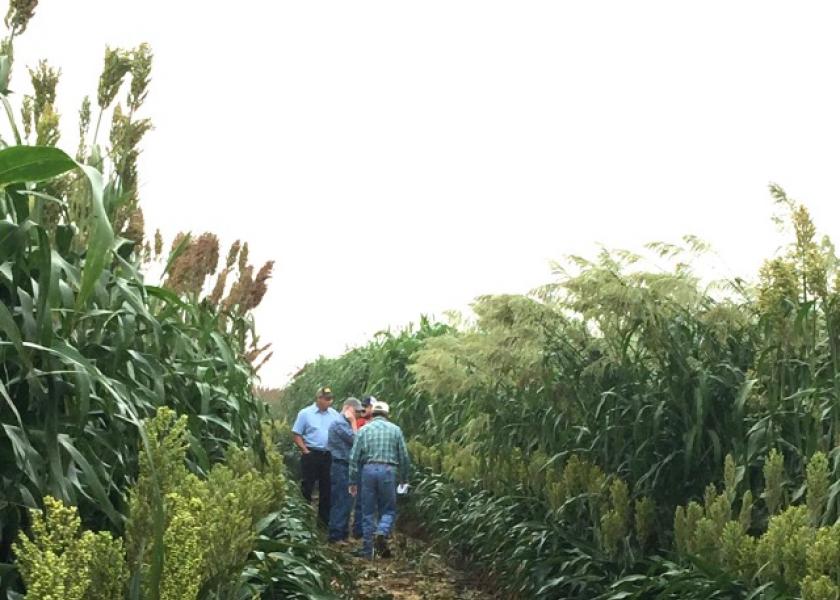AgriLife Extension Forage Sorghum Hybrid Trial has Special Purpose

Data to be used for farm bill loan deficiency program.
By: Kay Ledbetter, Texas A&M AgriLife Extension Service
More than 100 forage sorghum hybrids from 13 commercial companies across the U.S. growing in a Texas A&M AgriLife Extension Service production trial have a unique role to play, according to an AgriLife Extension specialist.
In addition to forage yield and quality, the field trial on the Michael Menke farm east of Bushland will help evaluate the eligibility of sorghum varieties for the U.S. Department of Agriculture’s Farm Service Agency management assistance loans and loan deficiency payments based on grain yield and forage type, said Dr. Jourdan Bell, AgriLife Extension agronomist in Amarillo.
The Texas Panhandle Forage Sorghum Silage Trial conducted at Bushland historically has been used by the Farm Service Agency, or FSA, to update grain sorghum eligibility tables.
“This is the second year we’ve had this trial with Mr. Menke, which has allowed us to evaluate the hybrids under center pivot irrigation and managed for maximum production,” Bell said. “We have 100 different hybrids, and there are three replications of each, so it’s definitely a very big trial.”
“Last year grain yields were not collected from the trial, but they will be this year if requested by the company in order to update existing eligibility tables,” she said.
FSA characterizes sorghum in five classes: dual purpose having a yield potential equal to 100 percent of a hybrid grain variety; dual purpose having a yield potential equal to 80 percent of a hybrid grain variety; sterile; photoperiod sensitive and ineligible varieties.
Forage-only varieties are not eligible for loans, only loan deficiency payments, unlike dual-purpose varieties that are eligible for both, Bell said. Sorghum varieties are further categorized to determine their eligibility according to tannin or non-tannin and grazing or grain use.
Bell said the trial at Bushland also includes three varieties planted at different populations. The population for the larger trial was 100,000 seeds per acre, based on longtime research data. But the three selected varieties were also planted at 75,000 seeds per acre in order to evaluate performance and lodging at a lower population.
“Based on previous data, 100,000 seeds per acre is a good planting rate to optimize production, especially under irrigation, but there is the potential to enhance lodging with certain varieties. We realize that this is not a recommended population for many varieties, but we are trying to maximize production,” she said.
Bell said the trial has only received about 4.5 inches of irrigation this year due to the rain received from May through July. The field received 12.4 inches of rain since planting on June 24, but there has been 25 inches of rain since May 1. That was one reason for the late planting date – the field was under water much of the time until late June.
“We’ve had really good weather pushing this sorghum along,” she said.
But on the down side, Bell said the trial has been hit by sugarcane aphids and has been treated once.
Harvest is underway, but it will continue through next month as every hybrid is harvested for silage when it reaches soft dough, she said.
“With the forage sorghum silage, it is critical that we optimize harvest time for quality. Silage pit management and end-use quality is strongly affected by harvest stage,” Bell said.
“If the silage is harvested prior to soft dough without additional drying, increased moisture contents can result in amplified butyric acid levels in the silage pit, which reduces palatability. When harvest is delayed to hard dough, moisture is often less than 60 percent, which results in poorly packed silage pits and poor fermentation.”
She said with all the dairies, the forage sorghum silages are a great fit for this region because they can be produced with about half the water as corn silage.
“One of the things we have seen is quality varies among varieties. There are some brown mid-rib varieties that are very good and some that aren’t, the same with non-BMR varieties. That’s why this field trial is something really great to see and have everything in the same location to look at.”







